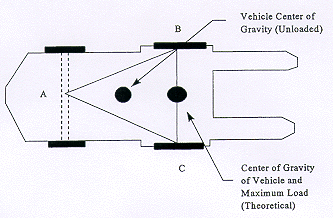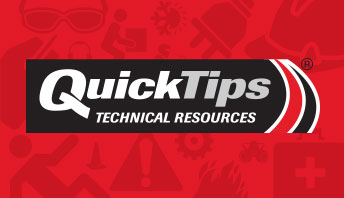

Forklift Safety Training Guide
By Grainger Editorial Staff 5/29/23


Quick Tips #106
The Occupational Safety and Health Administration (OSHA) defines a powered industrial truck (PIT) as any mobile, power-propelled truck used to carry, push, pull, lift, stack or tier materials, whether ridden by an operator or controlled by a walking operator. There are many different types of (PITs), and each type presents different operating hazards. PITs are commonly known as pallet trucks, rider trucks, forklifts or lift trucks. They are extremely useful in the workplace if they are safely used by trained operators.
Background
OSHA revised the PIT general industry standard, 29 Code of Federal Regulations (CFR) 1910.178, in 1999 to include operator training requirements. Violations of the PIT standard rank in the top ten most frequently cited OSHA standards each year. One of the major citations is failure to train.
Forklift Safety Training Requirements
Employers must develop and implement a training program based on the general principles of safe truck operation, the types of vehicle(s) being used, the hazards they create and the general safety requirements of the OSHA standard to ensure that operators are properly trained.
Trained operators must know how to do the job properly and safely, as demonstrated by workplace evaluations. Formal (lecture, interactive computer learning, video, written material, etc.) and practical (demonstrations by the trainer and practical exercises by the trainee) training must be provided. Employers must also certify that each operator has received the training and evaluate each operator’s performance in the workplace at least once every three years.
Training must be conducted by persons who have the knowledge, training, and experience to train PIT operators and evaluate their competence.
Training Program Content
Operators must be initially trained in the following truck-related and workplace-related topics unless the employer can demonstrate that the topic is not applicable to the safe operation of the PIT in their workplace.
- Truck-related:
- Operating instructions, warnings, and precautions for the types of truck to be operated
- Differences between the truck and automobiles
- PIT controls and instrumentation location and use
- Engine or motor operation
- Steering and maneuvering
- Visibility
- Fork and attachment adaptation, operation, and use limitations
- Vehicle capacity
- Vehicle stability
- Vehicle inspection and maintenance required to be performed by the operator
- Refueling and/or charging and recharging batteries
- Operating limitations
- Other operating instructions, warnings, or precautions listed in the operator's manual
- Workplace related:
- Surface conditions where PIT will be used
- Load composition and stability
- Load manipulation, stacking, and unstacking
- Pedestrian traffic areas
- Narrow aisles and other restricted areas
- Operation in hazardous (classified) locations
- Ramp and other sloped surface operation
- Operating the vehicle in closed environments or other areas where insufficient ventilation could cause problems
- Other unique or potentially hazardous environmental conditions
Because PITs are manufactured by different companies with various models available, the training must be specific to the operating characteristics of the specific PIT being used.
If an operator was previously trained on any of the truck or workplace-related topics, and the training is appropriate to the truck and working conditions encountered, additional training on that topic is not required if the operator has been evaluated and found competent.
Evaluation and Refresher Training
An evaluation of the performance of each PIT operator must be conducted at least every three years. OSHA requires that formal refresher training be conducted under certain circumstances. There is no set frequency, but employers do need to retrain when:
- The operator has been observed to operate the vehicle in an unsafe manner;
- The operator has been involved in an accident or near-miss incident;
- The operator has received an evaluation revealing that the operator is not operating the PIT safely;
- The operator is assigned to drive a different type of PIT; or
- A condition in the workplace changes that could affect safe operation of the PIT.
Certification
The employer must certify that every operator has received appropriate training, has been evaluated and has demonstrated competency in performing their duties. The name of the trainee, date of training, evaluation date and name of the person(s) performing the training or evaluation must be included on the certification.
Frequently Asked Questions
Q: What is the stability triangle?
A: Most counterbalanced PITs have a three-point suspension system. The PIT’s steer axle is attached by a pivot pin in the axle’s center. When these three points are connected with imaginary lines, the stability triangle is formed. When the center of gravity remains within the stability triangle, the PIT is stable and will not tip over. An unloaded PIT on a level surface will have a center of gravity in the middle of the stability triangle. As a load is added, or if the PIT is on an inclined surface, the center of gravity will move within the stability triangle. If the center of gravity moves outside of the stability triangle, the PIT may tip over.


Sources 29 CFR 1910.178, Powered Industrial Trucks
Occupational Health and Safety Administration (OSHA), Powered Industrial Truck etool
The information contained in this article is intended for general information purposes only and is based on information available as of the initial date of publication. No representation is made that the information or references are complete or remain current. This article is not a substitute for review of current applicable government regulations, industry standards, or other standards specific to your business and/or activities and should not be construed as legal advice or opinion. Readers with specific questions should refer to the applicable standards or consult with an attorney.







